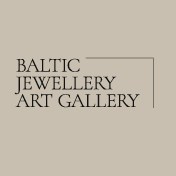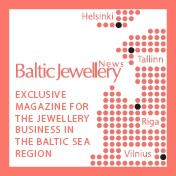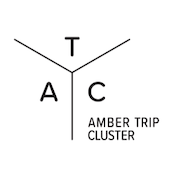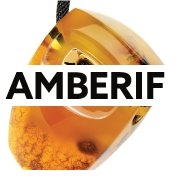Choice
.png)
About Amber Trip Award 2023 Winners by Cristina Filipe
In tribute to Giedrius Guntorius
Like no one else, he was able to inspire, create, love and care unconditionally.
Now all we have left is love, which is much stronger than death. [2]
Like no one else, he was able to inspire, create, love and care unconditionally.
Now all we have left is love, which is much stronger than death. [2]
‘– Obrigado!’ was one of the few Portuguese words he said to me at the closing of the XIX Amber Trip - International Baltic Jewellery Show last March in Vilnius. With a winning smile, he was a passionate, enthusiastic and unconditionally generous man, founder, organiser and host of this yearly event that started in 2004. We could never have imagined last March that it was to be his last Amber Trip event.
His contribution towards promoting Lithuania as an attractive Baltic region, famous for its amber and contemporary artistic jewellery is incalculable. Giedrius Guntorius possessed boundless energy and an outstanding capacity to programme and arrange meetings between people of different cultures and backgrounds around the theme of amber. He supported, inspired and motivated so many people. He brought together jewellery communities in the Baltic states and thanks to Baltic amber, he made them known throughout the world.
I received the kind invitation to be a jury member at the Amber Trip Art Jewellery Contest during the XIX Amber Trip - International Baltic Jewellery Show from Laima Kėrienė, artist and professor responsible for the jewellery course at the Faculty of Telsei of the Vilnius Art Academy. Within this framework I gave a lecture on contemporary jewellery in Portugal. I presented my book on this subject and gave a Cold Sweat workshop to an extraordinary group of students from this faculty.
I found Vilnius very inspiring both for its history - which I tried to link with the theme of my workshop beforehand - and for my direct contact with this totally mystical material: Amber.
Amber Trip takes place in an ample venue that also plays host to a large fair showing different ways to commercialise this fascinating material, which is as seductive as it is versatile, and contemporary jewellery through works by the various award-winning artists of the previous event as well as other participating artists, especially students and graduates from schools and universities in Lithuania. We can also attend a number of conferences given by members of the contest jury, among others guests, on each year’s topic of their own particular interest and area of research. Works submitted to the contest are displayed in the area dedicated to art jewellery.
The Choice was the theme Laima Kėrienė put forward as inspiration for artists taking part in the XIX art competition. The challenge presentation text says:
In a world full of stress, it’s becoming increasingly difficult for people to travel, to work, to get to know others and one’s own self in different cultural contexts. Our ideals and openness are reaching their limits. We need to choose with discernment so that our decisions do not lead to dead ends and fall into the trap of evil and lose hope in life. We can no longer ignore the urgency of choosing lifestyles, values such as good or evil, freedom or violence, respect or contempt, fullness or emptiness, construction or destruction. The heart and the mind navigate between the inevitable and what depends on our efforts. [3]
89 works created by 68 artists of 13 nationalities responded to this call and were displayed anonymously in an exhibition open to the general public for the duration of the event between 15 and 18 March 2023. Names of artists and results were only announced on the last day. Nevertheless, some works clearly revealed the artist’s language and world. A brief synopsis and caption for each entry helped us contextualise the work.
The Grand Prix, Best Jewellery, Best Object, Best Amber, Honorary Mention and Public Voice prizes were to be handed out to 8 artists from 6 countries. Each jury member could also select an artist for an honorary mention.
Laima Kėrienė; Ginte Grube, Latvia-based jewellery artist, theoretician and a board member at the Latvian Jewellery Art Association; Henrik Kihlman, silversmith and designer, CEO of the Finnish Goldsmiths Association; Giedimyn Jablonski, artist, academic teacher, curator and visiting professor at The Academy of Fine Arts in Wroclaw, Poland; and I were invited as members of the jury to award the prizes at this XIX edition. It was an honour to be part of such a challengingly diverse, skilled and really committed jury. We looked at the works individually and made a choice per category. The works we had all selected were then reassessed and each jury member given the opportunity to defend their choices. Criteria were compared and given the diversity of works, we learnt more about how each selected work was seen and reassessed by those who had selected them. As it is a democratic competition, in which everyone may take part, there is great eclecticism in the range of jewellery of very contrasting quality levels. As a jury member, I was impressed by the diversity of forms and combinations of materials, and even more so by the conceptual proposals intrinsic to each project and the contest topic.
It is important to note that the jewellery works entered for the competition are not required to incorporate amber except for the Grand Prix and Best Amber categories.
Two jewellery pieces, brooches, Succio the Suctus series created by Ruudt Peters (NL, 1950), stood out because of the sacred and metaphorical manner they present amber with singular, austere cutting that makes one think of a body/relic. Both lie in an open gilded silver and oxidized anthracite ash container, which could be either a cradle or tomb that frames and protects the amber. Their meticulous design and technique, distinctive shape and the way amber is cut and associated to the suggested contents so impressed the jury that it was unanimously awarded the Grand Prix.
The jury admired Half a World Away, the brooch created by Kelly McCallum (CA, 1979) for its figurative story-telling of multiple amber fragments presented as an archaeological find next to an electroformed bronze scarab beetle, revealing the dilemma of choosing between the amber fragments and the only plastic ‘trash’ fragment that stands out. A micro-landscape that reflects critically on the state of nature and animal life on Earth, it was attributed the Best Jewellery prize.

Best Jewellery: Kelly McCallum, Half a World Away
Unbroken created by Artūr Manukian (LT, 2001) and 30s to Live by Lina Vainoraitė (LT, 1983) complement the other in their fragility both in form as in concept and thus received the Best Object prize.

Best Object: Artūr Manukian, Unbroken

Best Object: Lina Vainoraitė, 30s to Live
A broken, vulnerable porcelain mug confronts adversity with resilience. For the artist, It represents not only the decisions we make, but also the beauty that can arise from our ability to pick up the pieces and move forward. The piece invites the viewer to consider their own choices and how they have the potential to shape their life's journey, just as the wire has brought the broken mug back to a state of cohesion. While a half-eaten slice of bread in gilded silver is a disconcerting metaphor for the 30 seconds soldiers are allowed in order to eat during the war.
I carry, I carry the egg by Aušra Mačiulaitienė (LT, 1982) won the Best Amber category and brings two fresh eggs in a carton together with two egg halves made of amber. It’s persuasive and enigmatic for the singularity of its form-function relation and the symbolism of its inherent concept. It’s presented in the form of a traditional children’s game in which a group of players are invited to sit in a circle and wait until they sense that the egg has or hasn’t been left on the floor behind their backs. They then run to get back to their places again if they manage to catch the player who left the egg behind them. The artist explains the moral of the game: Don’t let’s be rotten eggs. Let’s choose for ourselves, create our own destiny and follow our inclinations. Let’s not wait but go forward for ourselves!

Best Amber: Aušra Mačiulaitienė, I carry, I carry the egg
To Be or Not To Be by Dorota Pitra-Ptaszek (1981) and Dilemma Necklace by Roberto Zanon (IT, 1963) were distinguished with Honorary Mentions. Their two necklaces, seemingly opposites as one is geometric and the other is figurative, have much in common in their formal construction and how their parts are linked: one by means of geometric elements (like a Mecano set) and the other by human figure cut-outs (mother and daughter holding hands) and then replicated in silver. The choice theme in both works is also seen from an existential viewpoint: for Zanon, in a broad sense, while for Pitra-Ptaszek, it’s the specific sense of motherhood and the difficulty to make decisions about procreation, which always hovers between ‘sadness and fear’, ‘happiness and hope’.

Honorary Mention: Dorota Pitra-Ptaszek, To be or Not To Be
.jpg)
Honorary Mention: Roberto Zanon, Dilemma Necklace
To Forgive (To Lose), the ring created by Danielius Aldakauskas (LT, 2003), was almost unanimously chosen by the public for the Public Voice prize. The artist manages to create with the same material, silver, a strong contrast between a clean, polished form and an irregular, oxidised form. The inherent significance of this surprising proposal, for its nihilistic although poetic feelings about our present day, is described as:
to be. to be here. to observe the world. to see it change. the environment keeps on carrying its heavy burden as if it is some tribute to us. the environment is pressing on us like a cruel and heavy millstone. squeezing us into limits. dictating. what. wow. when. why. with who. our being. the stories told by our parents teach us. teach. how to understand the world. how to know ourselves and others. the human being of the XXI century is confused. lost. hesitant about the humanistic values (do they still exist?). we all become the fruits of hedonism. the primary fruits of the starved spirit are innovations that pressure but feed us simultaneously. in which corner of the human spirit lies conscience, humanity, and inner peace, it's like they keep on waiting in little rooms when, oh when they can speak up. sometimes they speak. whine. sometimes even howl. maybe the passer-by you met yesterday was your conscience gone for a walk in the wide world? [4]
Aldakauskas, probably one of youngest artists in the competition, was impressive in his committed manner at the award presentation when he expressed the significant impact this prize has on his life/career and highlighted the creative stimulus of this competition.

Public Voice: Danielius Aldakauskas, To Forgive (To Lose)
Finally, each jury member awarded an honorary mention to a piece: Sunflower by Artūras Davainis (LT, 1965) was selected by Laima Kėrienė for focussing on the construction of peace: ‘the current idea of peace’ as she explained. Perception by Emilija Daraškevičiūtė (LT, 1999) selected by Cristina Filipe for synthesizing a ‘clear concept in a minimal form’. Domino by Dominika Janowska (PL, 2000) selected by Ginte Grube for its ‘architectural, direct, brutal’ character. Everything and Nothing by Rasa Ilginė, Dalius Ilginis (LT, 1982, 1985) selected by Henrik Kihlman for its ‘clarity of the idea’ and Eeva Wornell (FI, 1946) selected by Giedmyn Jablonski for the honesty in form and material of ‘low bow with a hat’.

Laima Kėrienė Honorary Mention: Artūras Davainis, Sunflower

Cristina Filipe Honorary Mention: Emilija Daraškevičiūtė, Perception

Ginte Grube Honorary Mention: Dominika, Janowska, Domino

Henrik Kihlman Honorary Mention: Rasa Ilginė and Dalius Ilginis, Everything and Nothing

Giedmyn Jablonski Honorary Mention: Eeva Wornell
The awarded works, as well as all other entries for the contest, reveal the urgent need of art in our lives. Art that is art should be devoid of any function and is presented here with the mission to spearhead multiple reflections that could definitely help each one of us to understand the state of the world, often in crisis, and to make better choices.
Cristina Filipe
August 2023
Notes:
[1]: Emilija Daraškevičiūtė, synopis of her work, Perception, in Amber Trip Art Jewellery Contest.
[2]:Odília Guntorius in https://www.facebook.com/amber.trip.9/?locale=lt_LT (2023-05-16).
[3]: Amber Trip Art Jewellery Contest presentation text, 2023.
[4]: Danielius Aldakauskas, synopsis of his work, Forgive (To Lose), in Amber Trip Art Jewellery Contest, 2023.







